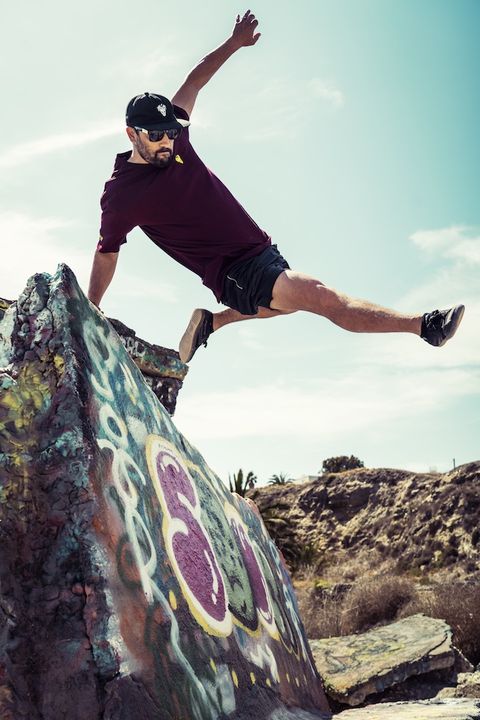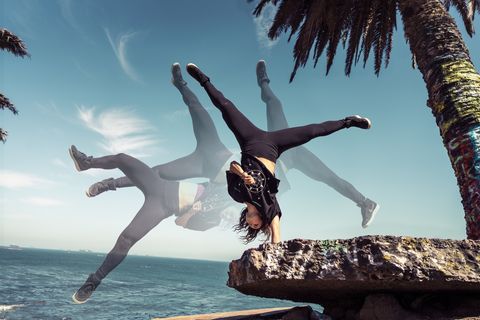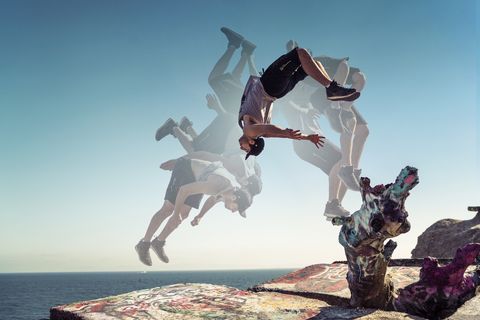Picture yourself at the top of a staircase with steel railings. Next to it is a five-inch-wide, seven-foot-high wall. How would you get down? If you’re like most people, you might stroll down the stairs. But if you’re Gabriel Nunez, the 37-year-old CEO of the Tempest Freerunning Academy in Chatsworth, California, all you see is possibility.You might sprint and jump into the wall, plant your feet, and then leap and flip off it, landing on the stairs below. Or you might grab the lip of the wall, lower yourself halfway, push your feet off, and flip onto the ground. Then maybe you’d hop up to the railing, run down it, and side-flip to the landing at the bottom. “Usually you start by climbing onto something,” says Nunez. “Then once that’s easy, you figure out how you might do it in a more creative way. . . . Freerunning is an exploration.”
This is how you see any space with walls, ledges, and railings (or any space outdoors) when you get into freerunning, the daredevil sport/art/way of life that’s growing in popularity—and can help energize your summer workouts.
At the heart of freerunning is a simple concept: constant movement. Your goal is to be playful and creative, swiftly making your way through a series of obstacles. Freerunning skills are the backbone of many Hollywood stunts, powering high-flying action-star chase scenes—involving everyone from James Bond and Jason Bourne to Captain America and Black Panther. Some of those stunt guys practice and sharpen their skills at Tempest.
Freerunning is an offshoot of parkour, which many believe was conceived in the early 1900s by French military officers as anew method of navigating obstacle courses. But parkour focuses on “usefulness,” pushing you to find efficient ways to move. In 2003, a British documentary called Jump London tracked three parkour athletes traversing London landmarks. None of them chased efficient movement; instead, they exuded style, surprising viewers with their acrobatics and leading French parkour athlete Guillaume Pelletier to coin the term freerunning. (Parkour, while still popular with movement zealots, suffered from taking itself too seriously and was famously parodied on The Office by Michael Scott.) Nunez, who was in college at the time, was intrigued by how freerunning took the best of parkour and fused it with imaginative, purposeful movement. Both freerunners and parkour athletes do similar tricks, but parkour athletes work through courses quickly. Freerunners aim to dazzle with acrobatics. If Parkour! is for Michael Scott, freerunning is for Marvel. “It was athleticism at its finest,” Nunez says. “But it was creative, and there was no boundary to it.”

Four years later, in 2007, RedBull created Art of Motion, a yearly freerunning competition that places competitors on a set course and asks them to zip through it, then judges them on the difficulty and creativity of their route. Four years after that, Nunez founded Tempest, a training ground, competition site, and classroom all in one. The sport—and Tempest—have gained traction ever since, fueled in part by Instagram, an ideal platform for acrobatic, “no way you can do that!” moves. Tempest now has more than 193,000 followers on IG and studios in California and Texas. The Chatsworth studio is freerunning’s de facto hub, with trampolines to boost your jumps, boxes to vault over, steel bars to balance on ,and foam bricks for soft landings. Plenty of stuntmen call Tempest home, but the gym also hosts classes in which average Joes fly through (or learn to fly through) obstacles.
You can learn the basics at home, though, and mastering just a few can jack up yourheart rate in minutes. You’ll build upper body strength and challenge balance and agility, two characteristics rarely trained in the gym. The experience may alter the way you approach fitness. “Athletics can make us change, grow, and evolve,” says Nunez. “There are no rules to this.” Start with these fundamentals from Tempest’s best.
Think Ahead in Midair
Stand up and walk around. Now realize this: Your eyes never have to look at your feet. You trust that your legs know what to do when you hit the pavement, even if you trip, so you look ahead at the obstacles you’re approaching. This, says Nunez, is one key to excelling at freerunning.
It’s much easier to maintain that confidence when walking, since one foot is always on the ground. In freerunning, that’s rarely the case. So you build trust using a low fence, park bench, or wide box by practicing the step vault, a fundamental freerunning move. “It’s safe, efficient, and comfortable,” says Nunez, and it’ll forge explosive leg strength, test your obliques, and build shoulder stability, too.
First, step up to an item no higher than hip height, place your right hand on it, and then place your left leg on it, bending your knee slightly. Move your right foot through the gap between your right hand and left leg, then step over the item. Aim to do 3 sets of 5 reps per side. As time progresses, you’ll be able to run up to the obstacle and jump toward it, then place your hand and step through.
Get On a Roll With Freerunning

Yes, you can do a vault, and you can jump on a box. But freerunning involves more than
a single stunt. The pulse of freerunning is “flow,” the ability to connect trick after trick without hesitation. When you do, say, a vault over a wall, land, roll, stand, run, and side-flip into a cartwheel—that’s flow.
Perhaps more than any other active competitive freerunner, 2019 Red Bull Art of Motion women’s champ Sydney Olson, 28, personifies flow. Olson, who served as the stunt double for actress Brec Bassinger in the second season of the CW’s Stargirl, started her career in gymnastics, which also challenges you to chain movements, but wanted
a sport with more freedom. “Gymnastics is very strict,” says Olson, whose nickname is Cyndi Turbo. “Freerunning lets me work through fear and learn new moves in the same way—without being so regimented.” Absent these limits, Olson can combine her favorite gymnastics-style flips and handsprings with simpler leaps, rolls, and tucks. One such simple move is the backward roll, which builds spinal mobility and core strength—and will have you feeling like a kid, too.
Start by sitting on the ground, knees tucked to your chest, arms bent, hands near the top of your head. Roll straight onto your back. Once your upper back and head are on the ground, press your palms into it, tuck your chin, and roll over the back of your head. Get your feet beneath you and land in the bottom of a squat. Do 3 sets of 5 to 10 per day.
Freerunning Lets You Progress in New Ways

Standard gym theory says progress means adding weight to a bar or reps to a set. But there are other ways to measure it, says Corbin Reinhardt, who performed stunts in the movie Moxie. “When you go to the gym, your progression in skill level is gonna be your PR,” says Reinhardt, who is 24. “Here, there’s no PR, you know. It’s just learning some new movement every day.”
This doesn’t mean flips one day and leaps off buildings the next. To Reinhardt, progression is about variation and creativity. For inspiration, he watches fellow freerunners on Instagram, then tries small, surprising alterations to make their moves his own. “Sometimes in my sleep, I’ll think of something,” he says. On his IG feed, you’ll see him perform flips and vaults off skateboards, on roller skates, and, for no particular reason, in a full dinosaur suit.
Borrow Reinhardt’s approach with one of his favorite drills, the box jump. Find a 6-inch- high box or platform, bend your knees, and leap (yes, leap) onto it, landing with your knees bent and your weight on the balls of your feet.
Do 5 reps, take a 60-second breather, then return to the box. Leap the same way, but this time, rotate your body to the right in midair and land only on your left foot. Do 5 reps, then repeat on the other side. Over time, introduce your own variations. You’ll hone athleticism and balance and improve your footwork for playground basketball and backyard tag.
Freerunning Teaches to Embrace Falling

Whether you’re on the basketball court, playing with the kids, or midway through your first freerun after reading this story, there’s always a chance you’ll take a tumble. Learn to fall correctly and it will hurt less or not at all.
Hunter Payton Mendoza, 16, knows this. At five-foot-six, he’s so powerful he can leap onto a 65-inch-high box. But seven years ago, that’s not what he needed to do for a flashback scene in the 2016 film Who’s Driving Doug. The director asked him to ride a runaway wheelchair down a steep hill. Hunter agreed—if he wasn’t belted into the seat. Good thing, too: On the first try, the chair flipped. Hunter leaped out. “If I’d let them belt me in, my face would have been crushed,” he says.
Hunter didn’t mind falling, because he’d mastered the safety roll at just seven years old. The safety roll is a key freerunning skill you can use to avoid injury, no matter if you’re leaping from a park bench or a moving car. The move helps break your fall, cushioning the impact on joints and bones alike.
Advanced freerunners also use it to change directions and cover territory in a dynamic way. To do it, stand, then step forward 3 to 4 feet with your right foot. Reach your right arm under your torso and toward your left foot, following your hand with your gaze. Then lunge deeply on your right leg and place the back of your right shoulder on the ground. Roll over your right shoulder; you’ll finish in a left-foot-forward half-kneeling stance. Do 3 or 4 sets of 5 reps. Start slow and progress to being able to do it at sprint speed.
A version of this story originally appears in the July/August 2021 issue of Men’s Health, with the title “Spint! Jump! Roll!”.
Source: Read Full Article
